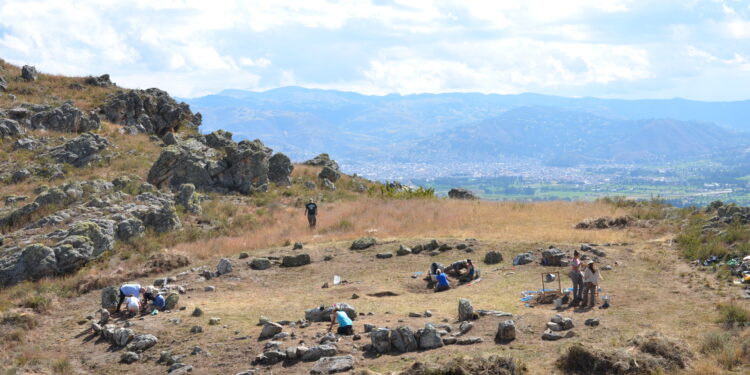A team including anthropologists from the University of Wyoming is working at the site of a circular plaza built about 4,750 years ago in the Cajamarca Basin of northern Peru. Credit: Jason Toohey
Two University of Wyoming anthropology professors have discovered one of the first circular plazas in Andean South America, featuring monumental megalithic architecture, which refers to construction using large stones placed vertically without mortar.
Located at the Callacpuma archaeological site in the Cajamarca Basin of northern Peru, the square is built with large megalithic stones placed vertically, a construction method unheard of in the Andes. Project leader Associate Professor Jason Toohey and Professor Melissa Murphy have been studying this topic since the project began in 2015. Excavations took place at the square from 2018.
Their paper, which reports new data on this first known megalithic circular plaza in the northern Andes, is titled “A monumental stone plaza at 4,750 BP in the Cajamarca Valley of Peru” and was published in Scientists progress.
Radiocarbon dating places its initial construction around 4,750 years ago, in the late pre-ceramic period, making it one of the earliest examples of such architecture in the Americas.
To better understand this timeline, the team carefully excavated the place, discovering artifacts related to past life and collecting charcoal samples to date them. All leftover materials were then cleaned, processed and analyzed in the laboratory.
“This structure was built about 100 years before the Great Pyramids of Egypt and around the same time as Stonehenge,” says Toohey.
These dates mean that the circular plaza of Callacpuma is the first known example of monumental and megalithic architecture in the Cajamarca Valley and one of the earliest examples in ancient Peru.
“It was probably a gathering and ceremonial place for some of the earliest inhabitants of this part of the Cajamarca Valley,” adds Toohey. “These people lived primarily a hunting and gathering lifestyle and had probably only recently begun farming and domesticating animals.”
The plaza is formed by two concentric walls and measures approximately 60 feet in diameter.
The project is led by Toohey and Patricia Chirinos Ogata of the University of California, Santa Barbara. The team also includes Murphy, as well as undergraduate and graduate students from Peru and the United States.
Toohey is an anthropological archaeologist dedicated to taking a holistic, multidisciplinary approach to the field. He has conducted fieldwork in the Peruvian Andes since 2003. Head of the Department of Anthropology at the UW, Murphy is a biological anthropologist specializing in bioarchaeology and committed to multidisciplinary approaches in anthropology.
“As part of our community outreach, we are collaborating and working with residents of towns on and around the Callacpuma site on our findings and their significance,” Toohey said. “We highlight the importance of cultural heritage and, by working together, we can continue scientific research and contribute to the preservation of the site.”
More information:
Jason L. Toohey et al, A monumental stone plaza at 4750 BP in the Cajamarca Valley of Peru, Scientists progress (2024). DOI: 10.1126/sciadv.adl0572. www.science.org/doi/10.1126/sciadv.adl0572
Provided by University of Wyoming
Quote: Research by anthropologists reveals a first stone place in the Andes (February 14, 2024) retrieved February 15, 2024 from
This document is subject to copyright. Apart from fair use for private study or research purposes, no part may be reproduced without written permission. The content is provided for information only.



